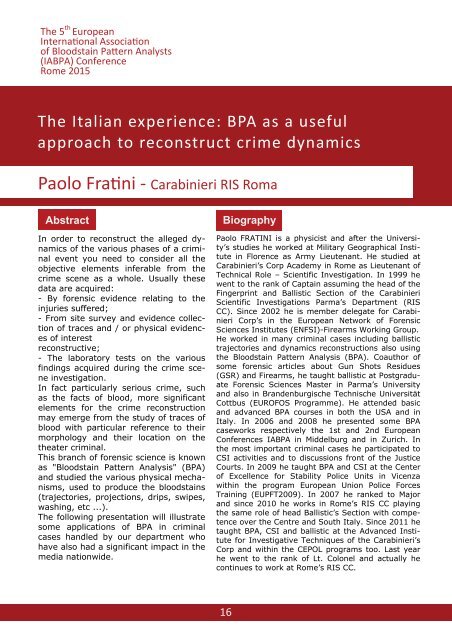5thEuropeanIABPAconferenceFinal programm
5thEuropeanIABPAconferenceFinal programm
5thEuropeanIABPAconferenceFinal programm
You also want an ePaper? Increase the reach of your titles
YUMPU automatically turns print PDFs into web optimized ePapers that Google loves.
The 5 th European<br />
Internaonal Associaon<br />
of Bloodstain Paern Analysts<br />
(IABPA) Conference<br />
Rome 2015<br />
The Italian experience: BPA as a useful<br />
approach to reconstruct crime dynamics<br />
Paolo Frani ‐ Carabinieri RIS Roma<br />
Abstract<br />
In order to reconstruct the alleged dynamics<br />
of the various phases of a criminal<br />
event you need to consider all the<br />
objective elements inferable from the<br />
crime scene as a whole. Usually these<br />
data are acquired:<br />
- By forensic evidence relating to the<br />
injuries suffered;<br />
- From site survey and evidence collection<br />
of traces and / or physical evidences<br />
of interest<br />
reconstructive;<br />
- The laboratory tests on the various<br />
findings acquired during the crime scene<br />
investigation.<br />
In fact particularly serious crime, such<br />
as the facts of blood, more significant<br />
elements for the crime reconstruction<br />
may emerge from the study of traces of<br />
blood with particular reference to their<br />
morphology and their location on the<br />
theater criminal.<br />
This branch of forensic science is known<br />
as "Bloodstain Pattern Analysis" (BPA)<br />
and studied the various physical mechanisms,<br />
used to produce the bloodstains<br />
(trajectories, projections, drips, swipes,<br />
washing, etc ...).<br />
The following presentation will illustrate<br />
some applications of BPA in criminal<br />
cases handled by our department who<br />
have also had a significant impact in the<br />
media nationwide.<br />
Biography<br />
Paolo FRATINI is a physicist and after the University’s<br />
studies he worked at Military Geographical Institute<br />
in Florence as Army Lieutenant. He studied at<br />
Carabinieri’s Corp Academy in Rome as Lieutenant of<br />
Technical Role – Scientific Investigation. In 1999 he<br />
went to the rank of Captain assuming the head of the<br />
Fingerprint and Ballistic Section of the Carabinieri<br />
Scientific Investigations Parma’s Department (RIS<br />
CC). Since 2002 he is member delegate for Carabinieri<br />
Corp’s in the European Network of Forensic<br />
Sciences Institutes (ENFSI)-Firearms Working Group.<br />
He worked in many criminal cases including ballistic<br />
trajectories and dynamics reconstructions also using<br />
the Bloodstain Pattern Analysis (BPA). Coauthor of<br />
some forensic articles about Gun Shots Residues<br />
(GSR) and Firearms, he taught ballistic at Postgraduate<br />
Forensic Sciences Master in Parma’s University<br />
and also in Brandenburgische Technische Universität<br />
Cottbus (EUROFOS Programme). He attended basic<br />
and advanced BPA courses in both the USA and in<br />
Italy. In 2006 and 2008 he presented some BPA<br />
caseworks respectively the 1st and 2nd European<br />
Conferences IABPA in Middelburg and in Zurich. In<br />
the most important criminal cases he participated to<br />
CSI activities and to discussions front of the Justice<br />
Courts. In 2009 he taught BPA and CSI at the Center<br />
of Excellence for Stability Police Units in Vicenza<br />
within the program European Union Police Forces<br />
Training (EUPFT2009). In 2007 he ranked to Major<br />
and since 2010 he works in Rome’s RIS CC playing<br />
the same role of head Ballistic’s Section with competence<br />
over the Centre and South Italy. Since 2011 he<br />
taught BPA, CSI and ballistic at the Advanced Institute<br />
for Investigative Techniques of the Carabinieri’s<br />
Corp and within the CEPOL programs too. Last year<br />
he went to the rank of Lt. Colonel and actually he<br />
continues to work at Rome’s RIS CC.<br />
16


